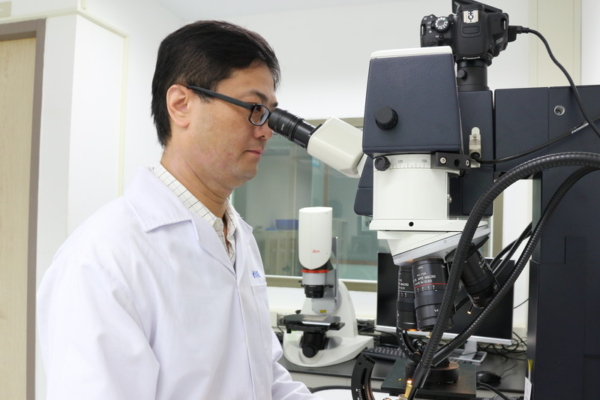The Criminal Investigation Bureau of the Ministry of the Interior of the Republic of China (Taiwan) has established the Criminal DNA Laboratory and Cold Case Center in order to investigate major criminal cases and provide crucial evidence, hoping to uncover the truth behind old cases. Over the past five years, they have solved more than 13,816 cases with the help of DNA identification, assisting in solving over 2,000 cases on average each year.
To improve forensic identification techniques, Lu Yu-chun, former director of the Criminal Investigation Bureau, instructed the planning of the Biological Science DNA Laboratory in 1992. He sent the then section chief, Huang Nu-en, to Dr. Lee Chang-yu’s laboratory in the United States for training. After personnel training and equipment preparation, Taiwan’s first Criminal DNA Laboratory was established the following year.
In order to investigate major unsolved criminal cases, with the assistance of Lee Chang-yu, the Criminal Investigation Bureau established the Cold Case Center in 2007. Cases classified as cold cases are defined as those occurring over 3 months ago, with relevant physical evidence but still awaiting technological breakthroughs for scientific verification, or cases of homicide, shooting, or sexual assault that have reached a standstill in investigation despite exhausting all investigative efforts. More than 70 cases that occurred after 1980 are still under review.
From the early days when there were only 2 forensic examiners handling 260 cases annually, Huang Nu-en, the current director of the Criminal Forensic Center, told reporters that the entire Forensic Center, including the Biological Science, Identification Science, and Fingerprint Science departments, now employs over 120 staff members and evaluates nearly 30,000 cases per year, providing crucial evidence in solving major criminal cases.
According to statistics from the Criminal Investigation Bureau, the Criminal Forensic Center has solved cases through DNA identification in the past five years as follows: 2,465 cases in 2019, 2,657 cases in 2020, 2,754 cases in 2021, 2,994 cases in 2022, and 2,946 cases in 2023.
The statistics show that in 2023 alone, there were 8,358 new case data entries, bringing the total number of DNA database files to 182,251, highlighting the workload and contributions of forensic personnel.
“With the continuous increase in cases, limited manpower will never be enough,” Huang Nu-en said. Currently, the Fingerprint Science and Biological Science departments of the Criminal Investigation Bureau are responsible for filing and identifying fingerprints and DNA separately, sharing the records with police stations nationwide. Each police station can conduct its own comparisons through a remote fingerprint matching system, with the Criminal Investigation Bureau assisting in verification.
Huang Nu-en pointed out that DNA laboratories and forensic centers have been established in the six municipalities, allowing for strategic resource sharing and tiered responsibilities to maximize limited manpower and accomplish the mission together.
She mentioned that in some areas where the crime rate is low, and forensic skills need more experience, such as over 2,000 sexual assault cases nationwide, they are still sent to the Criminal Investigation Bureau for analysis.
In the face of numerous criminal cases, there are rules for determining the order of forensic examinations. Huang Nu-en explained that cases with suspects in custody take priority because there are time limits to their detention. Gathering more information within the time frame can lead to breakthroughs in the case and appropriate consequences. Next in priority are major and special cases, such as the Mingyang Factory fire incident in Pingtung in 2018. Evidence was transported by train to Taipei, and forensic personnel immediately supported the investigation until the following morning, working throughout the night.
Huang Nu-en also cited the 2018 derailment of the Puyuma Express train as a similar example. The incident resulted in heavy casualties, prompting all forensic center staff to return to the laboratory to help. Everyone empathizes when faced with major events, diligently fulfilling their duties.
One of the cases that was successfully solved due to the unwavering efforts of forensic personnel was the 1994 case of a female teacher surnamed Wu. Huang Nu-en shared that the victim’s father was a police officer in Taipei, and everyone within the system was well aware of his anxiety and distress throughout the investigation. Fortunately, this cold case was eventually solved through fingerprint matching with a new case; otherwise, closure may never have been achieved.
However, there are still many major cold cases waiting for the truth to come to light once again, including the long-pending Lin’s residence blood case, the case of Liu Bangyou, and the case of Peng Wanru. The authorities continue to pursue all leads to solve these cases, hoping to bring closure to the victims and their families.
Having witnessed the development of forensic identification technology in Taiwan from scratch, Huang Nu-en believes that the recent amendment of certain provisions in the Criminal Procedure Law last year, which enhances the identification system procedures, qualifications of examiners, and disclosure of interests of litigants, poses new challenges for forensic development. This includes increased requirements for written reports, examiner qualifications, and the likelihood of testifying in court, which may affect the willingness of some forensic personnel to continue their service. Therefore, the bureau will strengthen internal training and communication to retain talents in the Criminal Forensic Laboratory.
(Reference: Central News Agency)

